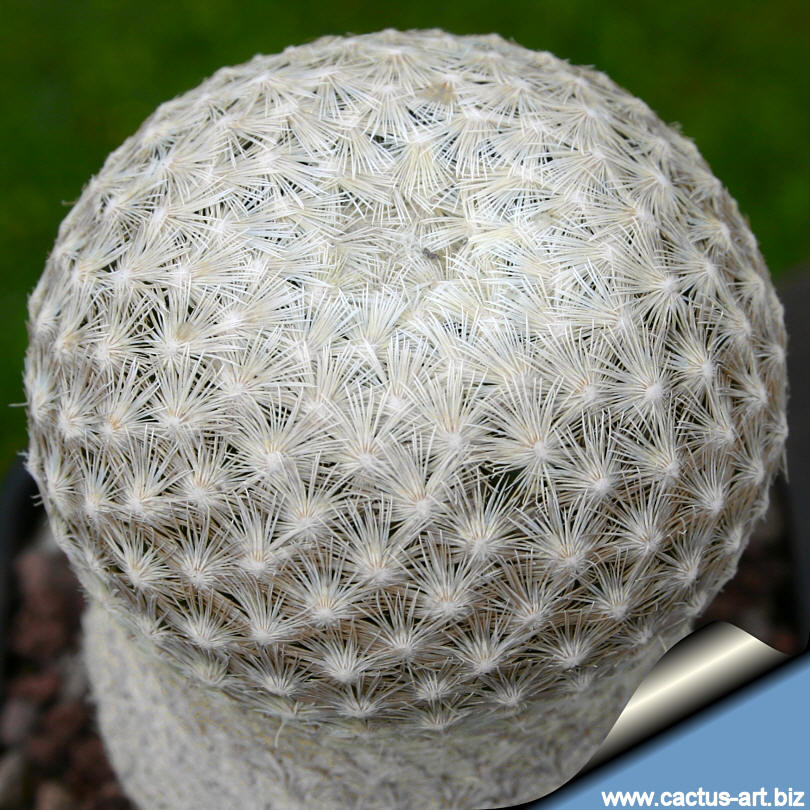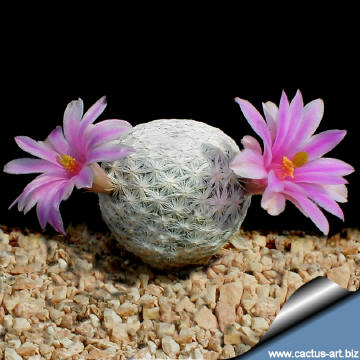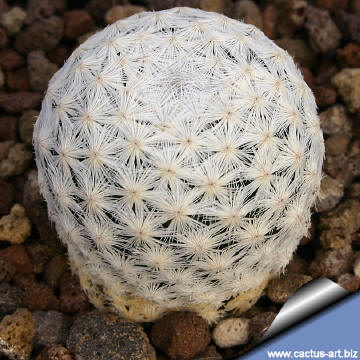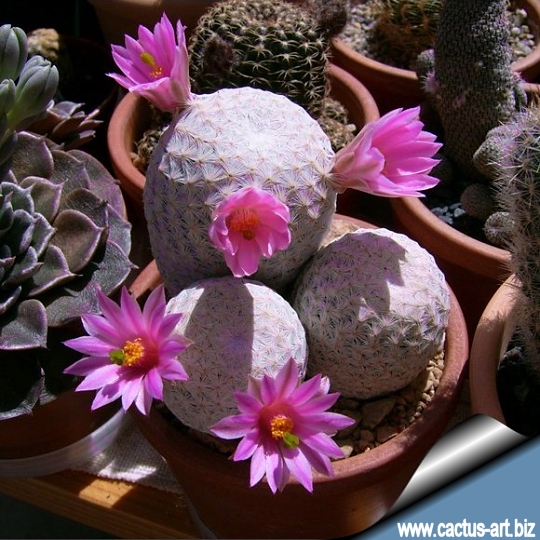|
|
|

Mammillaria herrerae.
This is one of the nicest small white species of Cactus, that may
at first glance
recall some forms of
M. humboldtii. What a beauty!
|
Description: It is small
growing cactus that look like a little golf ball. It usually
stays solitary, or occasionally clusters from the base.
Stems: Globose or slightly elongated as it ages, 2 - 3.5 cm in
diameter and height. (In cultivation it can grow very slowly up to 8 cm
tall). Without latex.
Tubercle: Closely set, cylindrical, terminally truncate. The axil
is naked.
Radial spine: 100 or more, unequal, interlacing, bristly, white
or grey, 1-5 mm long.
Central spine: Absent.
Flower: Diurnal, quite large for a Mammillaria, pale pink to
red-violet, 20 - 25 mm long and very showy.
Blooming season (Europe): April to May, it starts flowering when
it gets to be 5-7 years old, and reaches at least 3 cm in diameter.
Fruit: Globose, whitish, small.
Seed: Blackish brown.
|
|
 |
 |
|
The 100 or more white radial spines create
a lacy and friendly surface, smooth to the
touch. |
|
Advertising
|
|
|
|
Family:
Cactaceae (Cactus
Family)
Scientific name:
Mammillaria herrerae
First description by Wedermann, Motizbl. Bot. Gart. Mus. Berlin 11:276
(1931)
Series: Lasiacanthae
Origin: It is endemic to Queretaro, Mexico
Habitat:
It grows mainly in open places between grasses and calcareous rocks, in
association with other cactus species like Echinocactus grusonii,
Ferocactus hystrix and Thelocactus leucanthus. Altitude: 1.300 - 1.920 m.
This beautiful and peculiar cactus
was first described by Werdermann in 1931, and re-found in Queretaro,
Mexico under Lau's field number L 711 at Vista Hermosa, Queretaro,
Mexico, 1300-1800 m, in 9/6/1974.
Conservation status: Listed in
CITES appendix 2.
Synonyms:
-
Chilita herrerae
-
Escobariopsis herrerae
-
Neomammillaria herrerae
|
|
|
|

Photo and ©
copyright by
Mladen Turcinovic (Croatia)
|
|
Cultivation: This plant
isn't famous
for being easy to cultivate, but in good conditions
with excellent
ventilation,
it grows without difficulty.
It is especially sensitive to overwatering.
So careful watering and an open
mineral
potting soil are a must.
Avoid
the use of
peat or other
humus sources in the
potting mixture.
Don't add
limestone
to the potting mix
(which must be moderately acidic).
It can be sensitive to frost (but if dry
they are resistant to -5° C). Requires
maximum
sun exposure
to reach its full potential,
and to
achieve success in
flowering.
A winter rest that allows the plant to shrivel (perhaps losing up to
25% of its summer height) will encourage flowering and long time
survival. Be careful to encourage slow growth.
Provide very good
ventilation.
Propagation: Direct sow
after last frost. (it usually doesn't produces offsets).
Photo of conspecific taxa, varieties,
forms and cultivars of M. herrerae:

 |
|